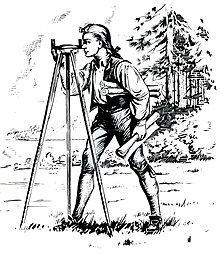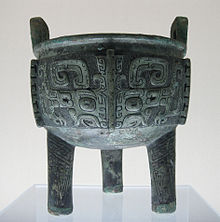Tripod

A tripod is a portable three-legged frame or stand, used as a platform for supporting the weight and maintaining the stability of some other object. The three-legged (triangular stance) design provides good stability against gravitational loads as well as horizontal shear forces, and better leverage for resisting tipping over due to lateral forces can be achieved by spreading the legs away from the vertical centre.
Etymology
First attested in English in the early 17th century, the word tripod comes via Latin tripodis (GEN of tripus),[1][2] which is the romanization of Greek τρίπους (tripous), "three-footed" (GEN τρίποδος, tripodos),[3] ultimately from τρι- (tri-), "three times"[4] (from τρία, tria, "three")[5] + πούς (pous), "foot".[6] The earliest attested form of the word is the Mycenaean Greek 𐀴𐀪𐀠, ti-ri-po, written in Linear B syllabic script.[7]
Cultural use

Many cultures, including the ancient peoples of China and Greece, used tripods as ornaments, trophies, sacrificial altars, cooking vessels or cauldrons, and decorative ceramic pottery. Tripod pottery have been part of the archaeological assemblage in China since the earliest Neolithic cultures of Cishan and Peiligang in the 7th and 8th millennium BC.[8] Sacrificial tripods were found in use in ancient China usually cast in bronze but sometimes appearing in ceramic form.[9] They are often referred to as "dings" and usually have three legs, but in some usages have four legs.
The Chinese use sacrificial tripods symbolically in modern times, such as in 2005, when a "National Unity Tripod" made of bronze was presented by the central Chinese government to the government of northwest China's Xinjiang Uygur Autonomous Region to mark its fiftieth birthday. It was described as a traditional Chinese sacrificial vessel symbolizing unity.[10]
In ancient Greece, tripods were frequently used to support lebes, or cauldrons, sometimes for cooking and other uses such as supporting vases.
Firearms

Tripods are commonly used on machine guns to provide a stable mount for the weapon when firing.[11]
Tripods are generally restricted to heavier weapons where the weight would be an encumbrance. For lighter weapons such as rifles, a bipod is more common. However, in recent times tripod saddles have become popular for precision rifle shooting sports, with the weapon placed in a vise-like rest which is mounted to a tripod head[12][13] or with the weapon mounted directly to the tripod head.
Photography
Usage

Tripods are used for both motion and still photography to prevent camera movement and provide stability. They are especially necessary when slow-speed exposures are being made, or when telephoto lenses are used, as any camera shake while the shutter is open will produce a blurred image. In the same vein, they reduce camera shake, and thus are instrumental in achieving maximum sharpness. A tripod is also helpful in achieving precise framing of the image, or when more than one image is being made of the same scene, for example when bracketing the exposure. The use of a tripod may also allow for a more thoughtful approach to photography. For these reasons, a tripod of some sort is often necessary for professional photography. In relation to film/video, the use of the tripod offers stability within a shot as well as certain desired heights. The use of a tripod within film/video is often a creative choice of the Director.
Construction
For maximum strength and stability, as well as for easy levelling, most photographic tripods are braced around collapsible telescopic legs, with a center post that moves up and down. To further allow extension, the center post can usually extend above the meeting of three legs. At the top of the tripod is the head, which includes the camera mount (usually a detachable plate with a thumbscrew to hold the camera). The head connects to the frame by several joints, allowing the camera to pan, tilt and roll. The head usually attaches to a lever so that adjustments to the orientation can be performed more delicately. Some tripods also feature integrated remote controls for a camera, though these are usually proprietary to the company that manufactured the camera.
Surveying
A surveyor's tripod is a device used to support any one of a number of surveying instruments, such as theodolites, total stations, levels or transits.
Usage
The tripod is placed in the location where it is needed. The surveyor will press down on the legs' platforms to securely anchor the legs in soil or to force the feet to a low position on the uneven, pockmarked pavement. Leg lengths are adjusted to bring the tripod head to a convenient height and make it roughly level.
Once the tripod is positioned and secure, the instrument is placed on the head. The mounting screw is pushed up under the instrument to engage the instrument's base and screwed tight when the instrument is in the correct position. The flat surface of the tripod head is called the footplate and is used to support the adjustable feet of the instrument.
Positioning the tripod and instrument precisely over an indicated mark on the ground or benchmark requires techniques that are beyond the scope of this article.
Tripods have also been used in the industry of film and photography since its invention was made to provide easier long exposure images for photographic studios.
Construction

Many modern tripods are constructed of aluminum, though wood is still used for legs. The feet are either aluminum tipped with a steel point or steel. The mounting screw is often brass or brass and plastic. The mounting screw is hollow to allow the optical plumb to be viewed through the screw. The top is typically threaded with a 5/8" x 11 tpi screw thread. The mounting screw is held to the underside of the tripod head by a movable arm. This permits the screw to be moved anywhere within the head's opening. The legs are attached to the head with adjustable screws that are usually kept tight enough to allow the legs to be moved with a bit of resistance. The legs are two part, with the lower part capable of telescoping to adjust the length of the leg to suit the terrain. Aluminum or steel slip joints with a tightening screw are at the bottom of the upper leg to hold the bottom part in place and fix the length. A shoulder strap is often affixed to the tripod to allow for ease of carrying the equipment over areas to be surveyed.
Astronomy
The astronomical tripod is a sturdy three-leg stand used to support telescopes or binoculars, though they may also be used to support attached cameras or ancillary equipment. The astronomical tripod is normally fitted with an altazimuth or equatorial mount to assist in tracking celestial bodies.[14][15]
Laboratory

Laboratory tripod is a portable, three-legged platform equipment, which is usually made of lightweight metal such as stainless steel or aluminium so that it can be moved conveniently within the lab. The main usage is to support or hold the flasks and beakers during experiments.
See also
- Bipod
- Monopod
- ISO_1222 (tripod screw mount)
- Trivet
- Triskelion
References
- ^ tripus. Charlton T. Lewis and Charles Short. A Latin Dictionary on Perseus Project.
- ^ Harper, Douglas. "tripod". Online Etymology Dictionary.
- ^ τρίπους. Liddell, Henry George; Scott, Robert; A Greek–English Lexicon at the Perseus Project
- ^ τρι- in Liddell and Scott.
- ^ τρία in Liddell and Scott.
- ^ πούς in Liddell and Scott.
- ^ ti-ri-po is found on the PY Ta 641 and PY Ta 709 tablets. 𐀴𐀪𐀠𐀆, ti-ri-po-de (found on the PY Ta 641 tablet), is the NOM dual form of the word. "The Linear B word ti-ri-po-de". Palaeolexicon. Word study tool of ancient languages. Raymoure, K.A. "ti-ri-po". Minoan Linear A & Mycenaean Linear B. Deaditerranean. "PY 641 Ta (2)". "PY 709 Ta (2)". DĀMOS: Database of Mycenaean at Oslo. University of Oslo.
- ^ Stark, Miriam T. (2006). Archaeology of Asia. Blackwell Publishing. p. 44. ISBN 978-1-4051-0213-1.
- ^ Wolfram, Eberhard. A History of China. Berkeley and Los Angeles: University of California Press, 3rd edition, 1969. Cf. p.49 for illustration of Ancient bronze tripod found at Anyang.
- ^ "National Unity Tripod presented to mark Xinjiang's 50th birthday". China: People's Daily. October 1, 2005.
- ^ "M122 Tripod". Army Study Guide. Archived from the original on 11 May 2021. Retrieved 25 June 2022.
- ^ Zant, Cal (26 March 2014). "Shooting Rest: HOG Saddle & PIG Saddle Review". Precision Rifle Blog. Archived from the original on 21 June 2021. Retrieved 25 June 2022.
- ^ Ewing, Melvin (30 August 2021). "Other Product Review HOG SADDLE – FULL REVIEW". Sniper Central. Archived from the original on 30 August 2021. Retrieved 25 June 2022.
- ^ "Telescope and Tripod". Universe Today. 21 May 2008.
- ^ Rotoni, Vito (23 May 2003). "Telescope Support Stand System: Background of the Invention". U.S. Patent and Trademark Office 7048238. Archived from the original on 2 April 2011. Retrieved 27 August 2009.
External links
 The dictionary definition of tripod at Wiktionary
The dictionary definition of tripod at Wiktionary Media related to Tripods at Wikimedia Commons
Media related to Tripods at Wikimedia Commons- Complete information of tripods
